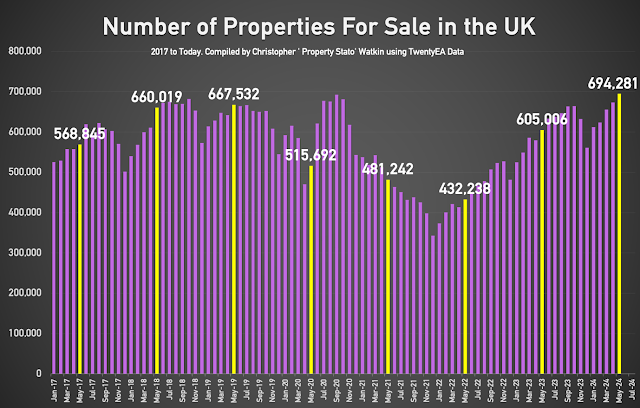The property market in the UK is a complex and multifaceted entity,
characterised by a myriad of factors that influence property prices and values.
One of the critical metrics often underutilised to gauge the value of
property is the price per square foot (£/sq.ft). This figure provides a
standardised measure, enabling comparisons across different regions and
localities.
In this article, we will delve into the £/sq.ft figures for the UK as a whole, the East Midlands region
(and how that compares to other regions), the Northampton property market and
why this £/sq.ft metric is particularly significant.
National Trends: The UK Perspective
Across the UK, property prices have seen significant fluctuations over
the past three decades.
The £/sq.ft figure is a valuable alternative indicator of these house
price changes (instead of the normal headline price). On average, the national £/sq.ft
is a composite reflection of diverse property markets, from the bustling urban
centres of London and Manchester to the serene rural areas of Scotland and
Wales and takes into account other aspects of house values.
The average £/sq.ft on the UK homes sold
in Q2 2024 was £343/sq.ft
This is up from £328/sq.ft in Q1 2023, a rise of 4.61%.
This figure encapsulates the varying dynamics of the UK housing market,
influenced by economic conditions, governmental policies, and demographic
shifts. The highest £/sq.ft can be found in W1 (Mayfair, Marylebone,
Fitzrovia, and Soho) up to the heady heights of £1,187/sq.ft. This is
driven by high demand, overseas buyers and limited supply.
Conversely, rural northern areas
exhibit lower figures, the lowest being in Shildon in County Durham (DL4) at
£77/sq.ft, due to the local economy, geography, housing stock and differing
lifestyle preferences.
Regional Focus: The East
Midlands
Let’s look closer to home, in
our region.
The average £/sq.ft on the
East Midlands homes sold
in Q2 2024 was £269/sq.ft
This is up from £262/sq.ft
in Q1 2023, a rise of 2.67%.
Our region has experienced steady growth in property prices, albeit at a
more moderate pace compared to the national trend.
The East Midlands has seen significant investment in infrastructure and
development projects, bolstering its property market prospects. Also, the
region's strong transport links, including major motorways and rail
connections, enhance its appeal.
Before we look at the Northampton numbers, let us compare all the
regions for Q2 2024 (and their growth in £/sq.ft levels from Q1 2023).
·
North East £188 sq.ft - a growth
of 6.82%
·
Scotland £213/sq.ft - a growth
of 7.04%
·
Wales £244/sq.ft - a growth of
5.17%
·
Yorkshire and The Humber
£247/sq.ft - a growth of 5.56%
·
North West £253/sq.ft - a growth
of 6.30%
·
East Midlands £269/sq.ft - a
growth of 2.67%
·
West Midlands £286/sq.ft - a
growth of 4.00%
·
South West £357/sq.ft - a growth
of 1.13%
·
East of England £393/sq.ft - a
growth of 1.03%
·
South East £437/sq.ft - a growth
of 1.39%
·
Outer London £549 sq.ft - a
growth of 1.48%
·
Inner London £779/sq.ft - a
growth of 3.04%
As you can see, the least expensive the region, the higher the growth in
house prices (£/sq.ft).
Local Insight: Northampton's Perspective
Zooming in further, let's examine the £/sq.ft figure for Northampton (NN1 to NN7).
The average £/sq.ft on the Northampton
homes sold
in Q2 2024 was £309/sq.ft
Up from £305/sq.ft in Q1
2023, a slight rise of 1.31%.
This figure reflects the town's unique blend of factors influencing
property prices. The presence of reputable schools and a vibrant community
plays a significant role and enhances its attractiveness to homeowners (and
landlords alike).
The town offers a balance between urban amenities and a suburban
lifestyle, appealing to families and individuals seeking a quieter yet
well-connected environment.
The local economy, supported by a mix of industries, also contributes to
the property market. Northampton's diverse employment base, coupled with
ongoing development projects, fosters a stable demand for housing.
Additionally, the town's cultural and recreational offerings, including leisure,
shops, and entertainment venues, enhance its appeal to prospective buyers.
The Importance of £/sq.ft: A Deeper Look
The £/sq.ft figure is not just a statistic; it is a crucial indicator of
the property market's health and trends. In a previous analysis, it was
highlighted that this metric offers a more immediate reflection of the market
compared to traditional indices such as the Land Registry or Nationwide House
Price Index. These traditional indices lag six to nine months behind due to the
time it takes to complete sales and register transactions.
The £/sq.ft measure allows for real-time tracking of property values,
offering insights several months ahead of official reports.
For instance, if the £/sq.ft figures indicate an increase, it can be
inferred that property prices are on an upward trend, even if official indices
have not yet reflected this change. This real-time data is invaluable for
buyers, sellers, and investors, enabling them to make informed decisions based
on current market conditions rather than outdated information.
Therefore, by following the trend of £/sq.ft figures, we can see house
price trends six to nine months ahead of official figures. This gives you the
ability to judge the top, bottom and general trends of the property market,
therefore giving you, the reader, an advantage into the Northampton property
market.
Final Thoughts: The Interconnected Dynamics of the National, Regional
and Local Northampton Property Markets
In summary, the £/sq.ft figures for the UK, the East Midlands, and Northampton
illustrate the interconnected dynamics of the property market.
Understanding these £/sq.ft figures provides valuable insights for
potential buyers, investors, and policymakers. It underscores the importance of
considering both macro and micro factors when navigating the property market.
As the market continues to evolve, staying informed about these metrics will be
crucial for making well-informed decisions in the ever-changing landscape of UK
property.
If you would like more information about the Northampton property market
and where it sits both regionally and nationally, then please do follow us on
social media, where we post lots of information which will help and guide you
on your property journey in the town.















